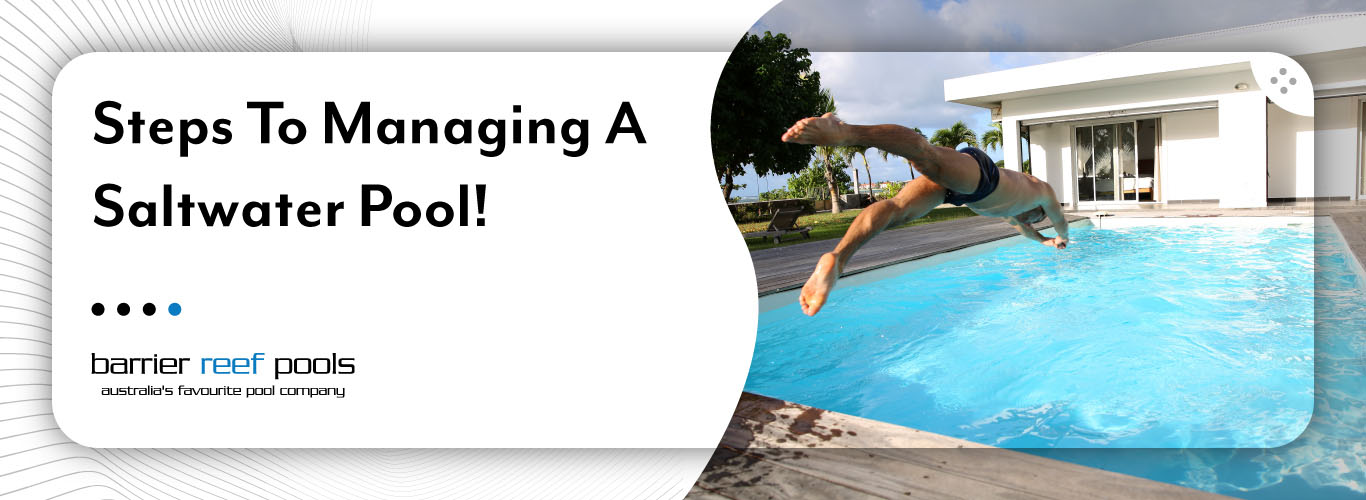Steps To Managing A Saltwater Pool
If you have a saltwater fibreglass pool and you are thinking of purifying it by adding some amounts of chlorine, stop! Cleaning and maintaining a saltwater pool the way you do a regular chlorine pool can do more harm than good. Before we begin explaining how to manage and maintain a saltwater fibreglass pool, let us first understand how it is different from a regular chlorine pool.

Difference Between A Regular Chlorine Pool And A Saltwater Fibreglass Pool
In a regular swimming pool, the water is regularly tested to identify the pH, alkalinity, calcium hardness, and chlorine levels. Accordingly, pool owners add chemicals to balance the pool water. Sometimes, shock treatments are also done to cleanse the water of all kinds of bacteria, algae, and other toxins. However, you need not do any of these in a saltwater fibreglass pool.
Unlike regular chlorine pools, saltwater fibreglass pools produce their own chlorine by a process known as electrolysis. All you have to do is add a pool grade salt to the chlorine generator. The chlorine generator processes the salty water by running it through two electrically charged plates. In this way, it forms chlorine. In comparison to traditional chlorine pools, saltwater fibreglass pools create a fewer amount of chloramines during the process of chlorine generation. Since chloramines are largely responsible for the feel and smell associated with regular chlorine pools, saltwater fibreglass pools do not have that smell.
Although saltwater fibreglass pools have softer water and require less maintenance in comparison to traditional pools, there are numerous things you need to do to maintain it in good order. Here is a quick guide with everything you need to know about managing and maintaining a saltwater fibreglass pool.
Unlike regular chlorine pools, saltwater fibreglass pools produce their own chlorine by a process known as electrolysis…
1. Maintain Proper Pool Circulation
The first step in maintaining a saltwater fibreglass pool is ensuring that the pool circulation is proper. If the pool circulation is improper, the saltwater gets concentrated in certain areas. To prevent the same, you must check if the pool water is able to rotate through all filters. As long as it is moving at a good pace, there is nothing to worry about. Several devices are available to check the saltwater pool circulation. The most common ones are salt concentration detectors.
2. Cleaning The Pool On A Regular Basis
Whether it is a traditional chlorine pool or a saltwater fibreglass pool, regular cleaning is crucial. Here is where you need to take extra care. The tools and cleaning devices used for traditional swimming pools do not work well in the case of saltwater pools. Therefore, when you go to purchase such devices, make sure to get the tools suitable for saltwater fibreglass pools. You must also pay attention to the cleaning procedure. Constant splashing of pool water may lead to high salt concentration outside the pool liner. This can lead to significant damage in the long run. To avoid splashing a lot of water outside the pool, use a hose or regularly spray down the area so that the salt is pushed back into the pool.
Additionally, if you see salt crystals anywhere in the pool, consider it as a warning. Immediately refer to the instructions of the manufacturer and solve the problem at the earliest. Also, do not forget to regularly clean the filter, pool pump, and skimmer.
3. Maintain Proper Salt Level
Measure the salt level in your pool. Mostly, it should be around 3400 ppm. If the salt level is very low, you can add pool salt to reach the optimal level. If it is too high, you will have to add fresh water to it.
4. Manage The Stabiliser
It is the stabiliser that stops chlorine from evaporating out of the pool. Most saltwater pool owners use cyanuric acid. This acid bonds very well with chlorine and ensures that it remains inside the pool. When the stabiliser is at the right level, the chlorine level also remains stable.

5. Manage The Level of pH
The ideal pH level of a saltwater fibreglass pool is 7.4. In saltwater pools, the pH level may increase continuously. That is why you must test it regularly and adjust the level accordingly. Both pH and chlorine level tests should be conducted regularly to ensure that the salt cell generator is functioning well and prevent the growth of algae in the pool.
6. Check The Salt Cell Generator
In a saltwater fiberglass pool, you need to inspect the salt cell generator frequently. To do so, first, turn off the power of the salt cell generator. It is safe to unplug it after switching it off. Next, unscrew the salt cell and pull it out. Now, visually check the metal plates present inside the cell. Minerals might get deposited on the same. They appear white and flaky. If you see such deposits, you might have to clean the generator either manually or using chemicals. If you do not see any mineral deposits, you can reassemble the generator and turn it on. The salt cell generator must be checked at least once in two months.
7. Winterise The Salt Chlorinator
Since you would not be using the pool during winters, you can winterise the salt chlorinator. As most saltwater units are unique, you need to consider the instructions of the manufacturers when winterising them. However, if the saltwater unit in your pool is easily detachable, it is recommended to remove it and keep it inside, away from the harsh winter elements.
From the above, it is clear that it is definitely easier to clean, manage, and maintain a saltwater fibreglass pool when compared with a traditional chlorine pool. Apart from that, saltwater pools are much cheaper in terms of the cost incurred on the day-to-day operations. Additionally, the less amount of chloramines makes the pool water gentler on the skin, hair, and eyes. So go ahead and have fun in your saltwater pool!
